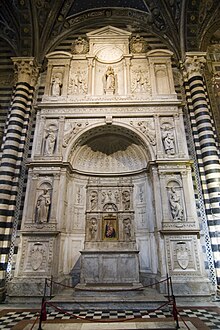Piccolomini altar
The Piccolomini Altar is an altar in the north aisle of the Cathedral of Siena .
history
Francesco Todeschini Piccolomini, later Pope Pius III. , intended to have an altar set up for himself and his family in the north aisle of the cathedral at Siena . This work, which took up the entire wall surface, was to be completed in 1485. The altar was made in Carrara marble by Andrea Bregno between 1481 and 1485 . Pietro Torrigiano was initially appointed for the figurative design . After creating the statue of St. Francis , he joined Cesare Borgia's army as a soldier and disappeared from Florence. The fact that Torrigiano Michelangelo had smashed his nose in the Scuola di San Marco was probably a motive for Michelangelo to accept the commission to complete the altar and thus to receive late satisfaction. The contract was signed on June 5, 1501 by the ecclesiastical dignitary and on June 19 or 25, 1501 by Michelangelo or Jocopo Galli .
The deposit was 500 gold ducats. Fifteen statues according to their measurements were to be delivered. However, these should first be approved by an independent expert. If the quality did not match, Michelangelo should have provided a replacement. Michelangelo was not allowed to accept any further orders within this period of three years. But Michelangelo could not resist the temptations of the free market in Florence (see David ) and so it happened that after this period he could not show a single statue to Piccolomini, who had meanwhile been raised to Pope. It is assumed, however, that the Bruges Madonna was originally intended for this commission. The heirs send Michelangelo a dunning letter with the offer to extend the contract by two years. With this impression, Michelangelo delivered five sculptures in October 1504, including the statue of St. Francis begun by Torrigiani. The others are St. Gregory, St. Pius , St. Paul and St. Peter . The statues are smooth routine work, which shows that they were created under time pressure and do not, as the treaty originally required, surpass all contemporary sculptures in Rome. Only in the statues of the apostles of St. Peter and Paul does he manage to leave the usual typology. In 1508 Michelangelo leaves the contract because he has taken over and pays the down payment of 100 gold ducats back to the heirs.
photos
Web links
literature
- Franz-Joachim Verspohl: Michelangelo Buonarrotti and Leonardo da Vinci, Everyday republican life and artist competition in Florence between 1501 and 1505. Berlin 2007, ISBN 3835302167 , pp. 93–98.
- Sebastian Halle: The Piccolomini Altar and the Bruges Madonna - The Piccolomini Madonna ?: On the current state of research. Grin 2011, ISBN 3656066876 .





